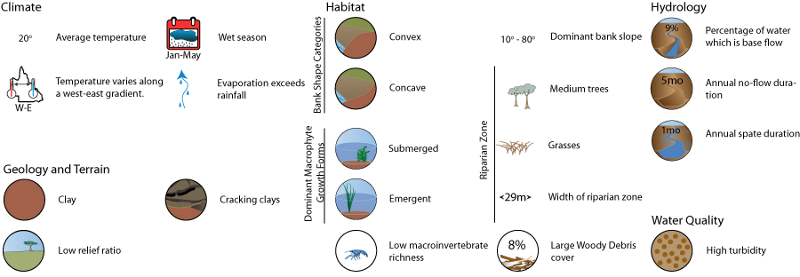|
|
Queensland Murray-Darling Freshwater Biogeographic ProvinceQueensland Murray-Darling Freshwater Biogeographic Province – Water quality  Click on elements of the model or select from the tabs below
Turbidity
Turbidity within the Murray-Darling FBP is generally high, but can be low at upland or headwater sites. At lowland sites, turbidity remains high even during the sometimes long periods between flows[2][1]. High turbidity has always been a natural feature of the river water in the Murray-Darling Basin[4]. Light penetration is generally limited to < 16 cm.
Information about primary productivity and light climate
Photic depthLight penetration of the water column has been investigated at 15 sites on the Warrego River in the Murray-Darling FBP. Photic zone depth is shallow, reflecting the high turbidity of the system[6]. Light is one factor governing rates of instream primary production because the growth of most aquatic plants is limited by light availability. Benthic metabolismBenthic metabolism has been measured twice at 30 sites throughout the Condamine Balonne system[7], four times from four sites and twice from a further 11 sites in the Warrego catchment[6] and once from 11 sites in the Border Rivers (Barwon, Weir and Macintyre catchments)[5]. Recorded GPP is on average low in the FBP, but is variable. Benthic respiration rates are on average higher than benthic GPP, meaning benthic communities in the FBP are typically net consumers of carbon. In some cases however, this situation is reversed, and they can be net producers of carbon. In contrast to rivers in the Lake Eyre and Bulloo FBP, rates of benthic metabolism in the Murray-Darling FBP are relatively low, despite similarities in climate, turbidity and nutrient status[6][7][3]. The underlying reasons for this are not known but may relate to differences in waterhole geomorphology, disturbance by introduced Carp (which are absent in the Lake Eyre and Bulloo FBP) or hydrology with more frequent flows in the Murray-Darling FBP[3]. Phytoplankton production can also occasionally be high in the surface waters of these turbid systems in Australia during periods of no-flow, as indicated by significant daily variations in dissolved oxygen[2]. Actual rates of water column production in waterholes have been estimated using measurements of dissolved oxygen change in sealed light and dark bottle chambers. These rates range from 1.5 mg C L-1 day-1 to 500 mg C L-1 day-1, during extended periods of no-flow[3]. Primary production and food webs in isolated waterholes have been studied in turbid floodplain rivers, typical of much of the Murray-Darling FBP[2]. In upland segments of some rivers within the Murray-Darling FBP, where turbidity is lower and flow less intermittent, light penetration is not as limited so benthic production is unlikely to be limited to littoral zones. In such situations submerged macrophytes also contribute to primary production. References
Last updated: 22 March 2013 This page should be cited as: Department of Environment, Science and Innovation, Queensland (2013) Queensland Murray-Darling Freshwater Biogeographic Province – Water quality, WetlandInfo website, accessed 18 March 2024. Available at: https://wetlandinfo.des.qld.gov.au/wetlands/ecology/aquatic-ecosystems-natural/riverine/freshwater-biogeo/murray-darling/water-quality.html |

 — Department of Environment, Science and Innovation
— Department of Environment, Science and Innovation

